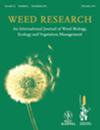Herbicide resistance in Alopecurus myosuroides: The value of routine testing of seed samples submitted by farmers since 1985
IF 2.2
3区 农林科学
Q2 AGRONOMY
引用次数: 0
Abstract
Abstract In 35 years of routine screening for herbicide resistance, a total of 3758 seed sample/herbicide combinations were assayed. Resistance testing was done in either pots in glasshouses (chlortoluron, fenoxaprop and mesosulfuron‐methyl + iodosulfuron‐methyl sodium) or Petri‐dishes in incubators (sethoxydim, cycloxydim and pendimethalin). With all herbicides, the relationship between herbicide efficacy and year of sampling was linear, with the slope representing the annual loss of efficacy. This was higher for the ALS inhibitors mesosulfuron + iodosulfuron (3.73% year −1 ) and ACCase inhibitors sethoxydim/cycloxydim (1.92% year −1 ) and fenoxaprop (1.36% year −1 ) than for the substituted urea chlorotoluron (0.69% year −1 ) and the dinitroaniline pendimethalin (1.10% year −1 ). These results are consistent with other studies on the relative resistance risk associated with these different modes of action. There was also a surprisingly good correlation between results for random and non‐random resistance testing, which has also been found in studies with other weed species in Canada and Australia. This indicates that routine testing of submitted samples can replace, at least partly, the need for random surveys which tend to be both labour intensive and expensive. These results, compiled over 35 years, show the value of routine resistance screening, not only for detecting resistance at the individual field level (‘micro’ scale), but also the distribution, evolution and impact of resistance country‐wide (‘macro’ scale). However, it is important that standardised testing methods, including appropriate reference populations, are used by different testing centres to ensure consistent results.1985年以来农民种子样品常规检测的价值
摘要在35年的常规除草剂抗性筛选中,共检测了3758份种子样品/除草剂组合。抗性试验在温室(氯脲、非诺沙prop和中磺隆-甲基+碘磺隆-甲基钠)罐中进行,或在培养箱(乙氧基肟、环氧基肟和二甲甲基萘)中的培养皿中进行。在所有除草剂中,除草剂药效与采样年份之间呈线性关系,斜率代表药效的年损失量。ALS抑制剂中硫隆+碘硫隆(3.73% - 1年)、ACCase抑制剂乙氧基/环氧基(1.92% - 1年)和非诺沙普罗(1.36% - 1年)的这一比例高于取代脲氯脲(0.69% - 1年)和二硝基苯胺(1.10% - 1年)。这些结果与其他关于这些不同作用方式相关的相对抗性风险的研究一致。随机和非随机抗性测试结果之间也有令人惊讶的良好相关性,这在加拿大和澳大利亚的其他杂草物种的研究中也发现了。这表明,对提交的样品进行例行检验可以至少部分地取代随机调查的需要,因为随机调查往往既耗费劳力又昂贵。这些结果汇编超过35年,显示了常规抗性筛选的价值,不仅在单个田间水平(“微观”尺度)检测抗性,而且在全国范围内(“宏观”尺度)检测抗性的分布、演变和影响。然而,重要的是,不同的检测中心使用标准化的检测方法,包括适当的参考人群,以确保一致的结果。
本文章由计算机程序翻译,如有差异,请以英文原文为准。
求助全文
约1分钟内获得全文
求助全文
来源期刊

Weed Research
农林科学-农艺学
CiteScore
4.30
自引率
0.00%
发文量
41
审稿时长
12-24 weeks
期刊介绍:
Weed Research is an international peer-reviewed journal that publishes topical and innovative papers on weed science, in the English language. Its aim is to publish the best weed science from around the globe and to be the journal of choice for weed science researchers. It is the official journal of the European Weed Research Society. Papers are taken on all aspects of weeds, defined as plants that impact adversely on economic, aesthetic or environmental aspects of any system. Topics include, amongst others, weed biology and control, herbicides, invasive plant species in all environments, population and spatial biology, modelling, genetics, biodiversity and parasitic plants. The journal welcomes submissions on work carried out in any part of the world.
 求助内容:
求助内容: 应助结果提醒方式:
应助结果提醒方式:


